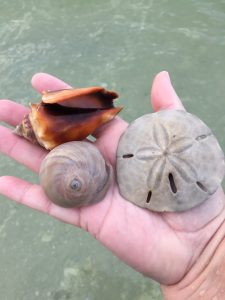If you love sand dollars, you’ll be pleased to hear that beach goers have been finding lots of them washed up on the shores of Captiva and Sanibel lately. I’ve been blessed to find a few, nearly white from being faded by the sun. I’ve also found lots of live sand dollars, which are illegal to keep, in Lee County. Do you know how to tell the difference?
How to Tell if a Sand Dollar is Alive:
Movement: Put the sand dollar in your palm. If its little hairs are moving, it’s alive. Those hairs or spines are called cilia.
Yellowing: Hold the sand dollar in your palm for a minute. If it leaves a yellow mark, it’s alive. (That substance is called echinochrome and it’s harmless to humans.)
Color: Sand dollars turn gray or white when they die. When alive, they can be dark brown to purplish-reddish.
Smooth or Hairy: If it’s smooth, it’s ok to keep. Sand dollars shed their spines/hairs when they die. If it’s hairy, place it back in the water.
Here are few more fun facts to share with your kids:
- Sand dollars move by using their spines/hairs (cilia).
- They live from 6 to 10 years.
- Sand dollars have teeth, five to be exact. (Have you ever shaken a sand dollar and heard it rattle? Those are the teeth!
- In the Legend of the Sand Dollar poem, the five doves are actually the sand dollar’s teeth.
- The mouth of the sand dollar is called “Aristotle’s Lantern.”
If you find sand dollars and want to pack them safely to bring home, wrap each one with paper towels, toilet paper or tissue and place inside a Tupperware-style container about the same size.
Also, a shelling charter to the out-islands may be just the ticket to finding a secret stash of sand dollars.
Happy hunting!

Live Sand Dollar.

Full moon and a perfect sand dollar.

Fingers stained yellow from live sand dollar.

seashells and sand dollar on Captiva.




